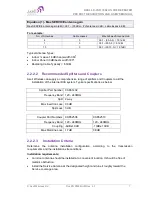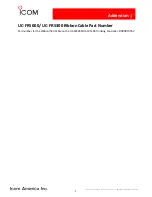
AXELL D-CSR 3302 US VHF REPEATER
PRODUCT DESCRIPTION AND US
ER’S MANUAL
10
Doc PN 0034B-UM Rev. 2.1
© Axell Wireless Ltd
channel as it will cause the MTBF of the repeater to drop dramatically, or even in the worst
case cause the repeater to fail completely.
If possible use a wall in the shadow to minimize the overall sun loading. If sufficient
shielding cannot be obtained, an additional sun shield should be mounted.
3-1. Example of a sun shield outdoors
Operating Temperature
The D-CSR repeaters are designed primarily
for multi carrier purposes. If the repeater is
run at full output power over a long period of
time the convection cooling might not be
enough. The repeater has a power
management function implemented that will
step down the power and if needed fully shut
down the amplifier chains until temperature
has reached normal values. In situations
where a repeater will be run in such a
manner extra cooling can be provided for
instance by putting the repeater in a
temperature controlled environment or via
external fans.
3.3.3 Wall Compatibility
Check the suitability of the wall on which the Repeater is to be mounted.
The Repeater wall mount brackets assembly should be fixed to a solid wall (these
include brickwork, blockwork, and concrete.);
(Due to the weight of the Repeater, it is NOT recommended to fix to a hollow wall).
3.3.4 Access to the Repeater
Plan connection cable clearances -
the Optical, RF and power connections located on
the underside of the Repeater will need at least 300mm vertical clearance below the
Repeater to enable the connections to be made. The minimum bend radius for Optical
and RF cables must not be less than the recommendations made by the cable
manufacturer. Plan the cable runs and ensure adequate space is available.
Allow for door opening
- ensure that there is sufficient space at the front of the
Repeater to allow the door to be fully opened and for maintenance engineers to get
access to the unit with test equipment such as a spectrum analyser.
Allow space around the repeater -
verify that there is a minimum of a 50 cm (20”)
radius of space around the Repeater, enabling easy access to the repeater for
maintenance and on-site inspection. Allow an additional 50 cm of space in front of the
Repeater when the door is fully open.
Monitoring repeater -
install the Repeater close to the service area to monitor the
output power.
















































